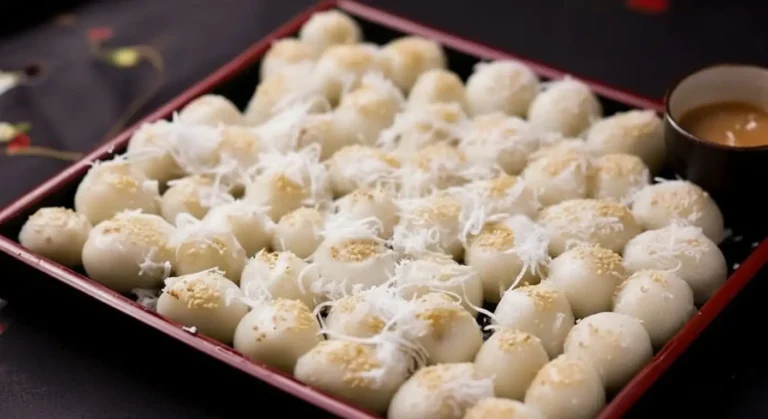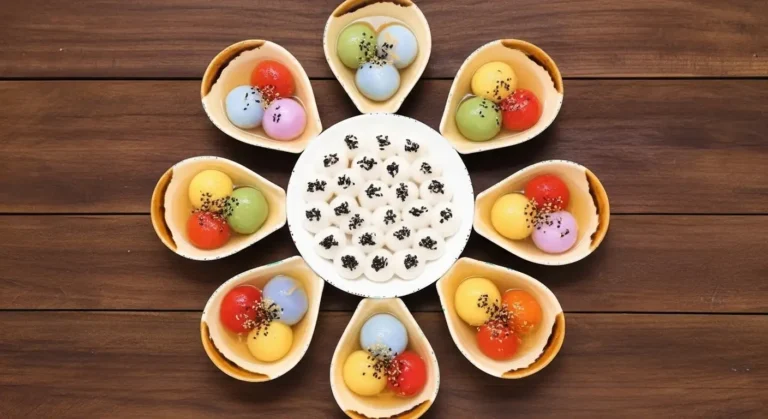Bánh Trôi Nước, a name that evokes both poetry and warmth, is one of Vietnam’s most cherished traditional desserts. This sweet soup, particularly popular during the cooler months, is a comforting, fragrant treat that holds deep cultural significance.
The Basics of Bánh Trôi Nước
What is it?
Bánh Trôi Nước translates to “Floating Balls in Water” or “Floating Cake in Water.” It is a sweet dessert soup consisting of glutinous rice flour balls with a sweet filling, served warm in a fragrant, golden-brown ginger syrup. It is sometimes categorized as a type of Chè (sweet soup/pudding).
The Components:
The Ball (Bánh Trôi): A chewy, soft outer shell made from glutinous rice flour (bột nếp).
The Filling: Traditionally, the balls are filled with a smooth, slightly sweet, and creamy mung bean paste (đậu xanh).
The Soup (Nước): The sweet broth is made from dissolving brown sugar (often palm sugar or brown cane sugar) in water, heavily infused with slices of fresh ginger to provide a comforting warmth and subtle spice.
Cultural Significance:
The dish is closely associated with the Hàn Thực Festival (Cold Food Festival) on the 3rd day of the 3rd lunar month, particularly in Northern Vietnam, where it is often served alongside the similar, but brothless, Bánh Trôi. The name and form of the cake were famously used in a classic poem by the 17th-century poet Hồ Xuân Hương, comparing the fate of women to the floating, rounded dumplings.

Types and Related Dishes
While the term Bánh Trôi Nước often refers to the specific dessert soup described above, it is closely related to other glutinous rice desserts, especially those from the North.
Chè Trôi Nước (The Southern Name): In Southern Vietnam, the dessert is almost exclusively called Chè Trôi Nước. It is fundamentally the same dish but is often characterized by a thicker, richer sauce thanks to the addition of coconut cream or coconut milk drizzled over the top before serving.
Bánh Trôi (The Northern Companion): This is a small, brothless version that is served on a plate rather than in a bowl of syrup. It is traditionally made with a filling of a small piece of red sugar (đường phên) and is simply topped with sesame seeds. It is eaten alongside Bánh Chay for the Hàn Thực Festival.
Bánh Trôi Tàu (Chinese-style): A variation popular in Hanoi, Bánh Trôi Tàu (often called Tàu as in “Chinese”) is a larger dumpling with fillings that may include black sesame paste or shredded coconut with ginger, served in a more heavily spiced, dark ginger soup—very similar to Chinese Tangyuan.
Filling Variations: Beyond the classic mung bean, vendors sometimes offer balls with fillings like taro, red bean, or even durian paste.
How to Eat Bánh Trôi Nước
Bánh Trôi Nước is a satisfying, warm dessert best enjoyed on a cool or cold day.
Served Warm: The dish is always served warm or hot to maximize the comforting fragrance of the ginger syrup and to ensure the glutinous rice ball is soft and chewy.
Toppings: The bowl is typically garnished with one or both of the following:
A generous sprinkle of roasted white sesame seeds.
A drizzle of rich, thick coconut cream (especially in the South).
Spoon Eating: Use a spoon to scoop up the entire dessert. Take a bite of the chewy rice ball with its sweet, creamy filling, followed by a spoonful of the warm, gingery syrup to balance the sweetness. The toasted sesame seeds provide a nutty flavor and pleasant crunch.
Mixing: Unlike Chè with crushed ice, Bánh Trôi Nước is generally not stirred aggressively; you enjoy the distinct element of the chewy ball submerged in the clear, fragrant syrup.

Regional Differences
The regional differences in Bánh Trôi Nước are mainly centered on its name, its sauce, and its traditional usage.
| Region | Name & Primary Characteristics | Flavor Profile Focus |
|---|---|---|
| North (Hanoi) | Primarily called Bánh Trôi Nước or Bánh Trôi Tàu (for the larger, sesame-filled version). Often served with a clearer, simpler ginger-sugar syrup and sesame seeds. | Subtle, Warming Spice. The focus is on the chewy texture of the rice cake and the clean heat of the ginger. It is an essential part of the Hàn Thực Festival. |
| South (Saigon/Mekong Delta) | Almost exclusively called Chè Trôi Nước. It uses the same mung bean-filled rice balls but is characterized by a generous, thick drizzle of creamy coconut milk/cream over the top. | Rich, Sweet, and Creamy. The addition of coconut milk makes the dessert much richer, aligning with the Southern preference for sweeter, bolder desserts. |
| Central (Hue/Da Nang) | Found across the region, often adopting characteristics of both North and South. The name Chè Trôi Nước is common. The preparation typically features the ginger-syrup base. | Spicy and Balanced. Reflecting the Central region's love for spice, the ginger syrup may be more potent than in the North, but the dessert is generally less intensely sweet than the Southern style. |




